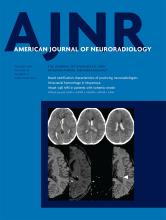Abstract
BACKGROUND AND PURPOSE: Prior retrospective studies have suggested that both T2 hyperintensity and gadolinium enhancement on fat-suppressed MR imaging are associated with lumbar facet joint pain, but prospective evaluation of FDG-PET/MR imaging with a standardized protocol and correlation to clinical findings are lacking. The primary aim was to prospectively assess a standardized FDG-PET/MRI protocol in patients with suspected facetogenic low back pain, with determination of the concordance of imaging and clinical findings.
MATERIALS AND METHODS: Ten patients with clinically suspected facetogenic low back pain were prospectively recruited with a designation of specific facet joints implicated clinically. Subsequently, patients underwent an FDG-PET/MR imaging examination with gadolinium. Each facet joint was graded for perifacet signal change on MR imaging and FDG activity. The frequency and correlation of MR imaging, FDG-PET, and clinical findings were determined.
RESULTS: FDG activity showed high concordance with high overall MR imaging scores (concordance correlation coefficient = 0.79). There was concordance of the clinical side of pain with the side of high overall MR imaging scores and increased FDG activity on 12/20 (60%) sides. Both a high overall MR imaging score (concordance correlation coefficient = 0.12) and FDG-PET findings positive for increased activity (concordance correlation coefficient = 0.10) had low concordance with the specific clinically implicated facet joints. Increased FDG activity or high MR imaging scores or both were present in only 10/29 (34%) facet joints that had been clinically selected for percutaneous intervention. Eleven (11%) facet joints that had not been selected for treatment demonstrated these imaging findings.
CONCLUSIONS: There was low concordance of perifacet signal change and FDG activity with clinically implicated facet joints. This could indicate either the potential to change patient management or a lack of biomarker accuracy. Therefore, additional larger randomized studies with the use of comparative medial branch blocks would be useful to further investigate the clinical utility of these findings.
ABBREVIATIONS:
- MBB
- medial branch block
- ρCCC
- concordance correlation coefficient
- SUVmax
- standard uptake value maximum
- © 2019 by American Journal of Neuroradiology












